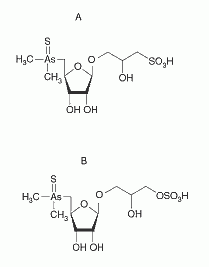As part of an ongoing project investigating arsenic speciation in food products, the research group from the University of Graz scanned several mollusc samples from the local fish market for thio-arsenosugars using HPLC-ICPMS under conditions optimized for detection of these arsenicals. Two novel thio-arsenosugars were identified in aqueous and methanol extracts from the gonad and the muscle of the great scallop. Due to their unusual chromatographic properties, these compounds are difficult to detect by existing methods for arsenic speciation analysis. To overcome these difficulties, the research group developed a new method based on HPLC-ESI-MS.
Chromatographing an aqueous extract of the gonad produced two unknown broad signals at long retention times of ~ 30 and ~54 min. Elution was about two times faster when 3% (v/v) methanol was used in the mobile phase. This unusual retention behaviour was previously observed for thio-arsenosugar-glycerol and thio-arsenosugar-phosphate, leading the researchers to speculate that the unknown signals represented two new thio-arsenosugars. A first indication about the structure of these thio-arsenosugars was obtained when the aqueous extract was treated with hydrogen peroxide. The two unknown signals completely disappeared, and the signals for arsenosugar-sulfonate and arsenosugar-sulfate increased significantly.

To confirm the presence of thio-arsenosugar-sulfonate (A) and thio-arsenosugar-sulfate (B), the original aqueous extract was spiked with synthetic standards of the two compounds. The spiking experiments produced enhanced undistorted peaks at the retention time of the two unknown compounds indicating their identity with the standards. For further confirmation, the group developed an LC-ESI-MS method that enabled identification of the two new compounds via their pseudomolecular and fragment ions.
By using the optimized method, the researchers confirmed that the thio-arsenosugars are present in fresh samples of the scallop, and are not just formed during storage or sample preparation. Further research is needed to study how these arsenic compounds are produced by living organisms and how they are metabolized by humans.

Markus Kahn, Reingard Raml, Ernst Schmeisser, Birgit Vallant, Kevin A. Francesconi, Walter Goessler,
Two Novel Thio-Arsenosugars in Scallops Identified with HPLC-ICPMS and HPLC-ESMS, Environ. Chem., 2/3 (2005) 171-176.
DOI: 10.1071/EN05045
 Related Studies
Related Studies

V. Devesa, M. A. Súńer, V. W.-M. Lai, S. C. R. Granchinho, D. Vélez, W. R. Cullen, J. M. Martínez, R. Montoro,
Distribution of arsenic species in the freshwater crustacean Procambarus clarkii, Appl. Organomet. Chem., 16/12 (2002) 692-700.
DOI: 10.1002/aoc.374

E. Schmeisser, R. Rami, K.A. Francesconi, D. Kuehnelt, A.L. Lindberg, C. Soros, W. Goessler,
Thio arsenosugars identified as natural constituents of mussel by liquid chromatography mass spectrometry, Chem. Commun., (16) (2004) 1824.
DOI: 10.1039/b406917j

Michael W. Fricke, Patricia A. Creed, Amy N. Parks, Jody A. Shoemaker, Caro
A. Schwegel, John T. Creed,
Extraction and detection of a new arsine sulfide containing arsenosugar in molluscs by IC-ICP-MS and IC-ESI-MS/MS, J. Anal. At. Spectrom., 19/11 (2004) 1454-1459.
DOI: 10.1039/b408416k

Concepcíon Almela, José Moisés Laparra, Dinoraz Vélez, Reyes Barberá, Rosaura Farré, Rosa Montoro,
Arsenosugars in Raw and Cooked Edible Seaweed: Characterization and Bioaccessibility, J. Agri. Food Chem., 53/18 (2005) 7344-7351.
DOI: 10.1021/jf050503u

Csilla Sörös, Walter Goessler, Kevin A. Francesconi, Ernst Schmeisser, Reingard Raml, Norbert Kienzl, Markus Kahn, Peter Fodor, Doris Kuehnelt,
Thio arsenosugars in freshwater mussels from the Danube in Hungary, J. Environ. Monit., 7/7 (2005) 688-692.
DOI: 10.1039/b503897a

J. Kirby, W. Maher, D. Spooner,
Arsenic Occurrence and Species in Near-Shore Macroalgae-Feeding Marine Animals, Environ. Sci. Technol., 39/16 (2005) 5999-6005.
DOI: 10.1021/es050546r

Paramee Pengprecha, Mhairi Wilson, Andrea Raab, Jörg Feldmann,
Biodegradation of arsenosugars in marine sediment, Appl. Organomet. Chem., 19/7 (2005) 819-826.
DOI: 10.1002/aoc.579

Reingard Raml, Walter Goessler, Pedro Traar, Takafumi Ochi, Kevin A. Francesconi,
Novel Thioarsenic Metabolites in Human Urine after Ingestion of an Arsenosugar, 2',3'-Dihydroxypropyl 5-Deoxy-5-dimethylarsinoyl-ß-D-ribose, Chem. Res. Toxicol., 18/9 (2005) 1444-1450.
DOI: 10.1021/TX050111H
 Related EVISA News
Related EVISA News
last time modified: October 15, 2024